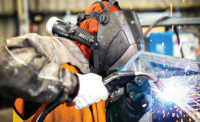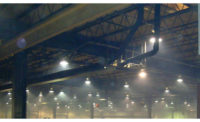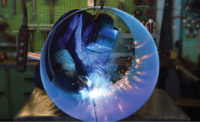Welding is so common across industries that its hazards are easy to overlook. Most professionals already understand the need for eye protection and burn prevention, but gas hazards deserve attention, too. Welding fume safety is an essential, if less evident, part of workshop safety.
All major welding types — arc, tungsten inert gas (TIG) and metal inert gas (MIG) — can produce hazardous fumes. Any welding operation must recognize this hazard and minimize its effects.
Welding fume risks
Welding fumes are unavoidable to an extent, as the very act of welding produces them. The flame or arc’s high temperature vaporizes the metal you’re working with, causing metal particles to drift through the air. Inhaling them can have severe health consequences.
Most welding fumes contain manganese, which can damage the lungs, kidneys, liver and central nervous system in high concentrations. Prolonged exposure can cause Parkinson’s disease-like symptoms, such as tremors, loss of balance and slow movement. Men may also be at greater risk of infertility after enough manganese exposure.
Manganese aside, inhaling foreign particles of any kind can be hazardous. It can lead to eye, nose and throat irritation, pneumonia, and asthma attacks.
Unlike burns and shocks, these effects may not manifest immediately, making them all the more threatening. Without weld fume extraction systems or similar protections, workers may not notice these risks until it’s too late.
How to ensure welding fume safety
You can work without worrying about these effects if you follow proper welding fume safety procedures. Here’s what a comprehensive safety plan should include.
Emphasize fume safety in training
As with other hazards, training is the first and most important step in welding fume safety. All welders should understand the risks of fume exposure and know which practices prevent it.
Welders should know what PPE is necessary for their job and how to wear it properly. Similarly, they should learn to inspect all equipment for leaks, cracks, broken seals or other issues before using it. Training employees to ensure proper ventilation before welding is also crucial, as a lack of airflow will make inhalation more likely.
While prevention is key, welders should also know how to recognize fume hazards to respond if something’s wrong. Early physical warnings include irritated eyes and nausea, so workers must stop immediately if they experience these symptoms. Unusual smells and hissing noises should also warrant further inspection.
Use a weld fume extraction system
It’s also essential to use a weld fume extraction system. It’s always best to eliminate hazards entirely, but that’s impossible with weld fumes. However, you can minimize exposure by using a procedure to remove fumes from the area before employees can inhale them.
Outdoor employees can enable natural fume extraction by remaining upwind. Indoor welding environments need mechanical ventilation systems. Fume hoods are ideal as they can vent toxic gases closer to the source, minimizing inhalation risks. Fume extractor guns can provide more targeted and portable ventilation where hoods aren’t viable.
Exhaust is another important part of weld fume extraction systems. Always position exhausts away from workers and toward open spaces. Employees should avoid walking too close to prevent inhaling these contaminants while not working.
Equip welders with appropriate PPE
PPE is another crucial component of welding fume safety. Most welders know they need gloves and weld masks to prevent burns and eye damage, but respiratory PPE is easier to miss.
OSHA only requires respiratory protection in poor ventilation, but it’s safest to exceed the minimum standard. All welders working indoors should wear respirators, even with a weld fume extraction system in place. Air-supplied respirators may be unnecessary, but standard industrial respirator masks should be part of every welder’s PPE.
Safety instructors must also ensure their teams understand how to wear and inspect PPE properly. Before working, employees should check their respirators for cracks, tears or other damage that may hinder their effectiveness. Workplaces should replace respirator cartridges at least every six months, even with light use.
Inspect and maintain equipment
Equipment failures can make welding fume hazards more prevalent. Consequently, ensuring all welding materials remain in top condition is essential. Broken or malfunctioning machines could cause leaks, leading to fume exposure even when workers aren’t actively welding.
Welders should inspect gas tanks, hoses and other equipment for damage at the start of each shift. Proper maintenance and storage are also essential. If inspections reveal any issues, workers should report them immediately to enable quick fixes. At the end of a shift, welders should store gas cylinders upright in a cool, dry and preferably locked area.
Some welding operations may have more complex maintenance needs. Facilities using robots to alleviate worker shortages should use Internet of Things (IoT) sensors to monitor these machines’ condition. That way, they can respond to maintenance issues before they become noticeable and expensive.
Monitor weld fume exposure levels
Ongoing monitoring is the final step in weld fume safety. Some equipment issues or workplace hazards may remain unnoticeable to human senses for extended periods. Regularly measuring metal contaminant levels provides a solution to that awareness gap.
NIOSH recommends manganese levels stay below 1 milligram per cubic meter of air. That’s five times less than the legal permissible exposure level (PEL). Workshops should adhere to this stricter standard when measuring contaminant levels to minimize risks. Workers will still likely be safe if responses are slow and levels fall slightly above that benchmark.
Manual measurements are acceptable but not ideal. When budgets allow, workshops should implement automated air quality monitoring systems. These advanced alternatives enable continuous checking without hindering efficiency, facilitating faster responses and ensuring workers don’t rush.
Welding fume safety is a must
Ignitions, burns and eye damage may be the most obvious welding hazards, but they’re not the only ones. Welding fume safety is also essential, especially because it may not be as evident in light of these other threats.
These five steps provide proper welding fume safety in any workspace. All welders should recognize the importance of these measures and implement them in their regular workflows to stay safe and work efficiently.




